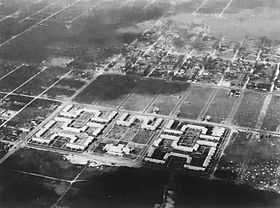Liberty Square (Miami)
| Liberty Square | |
|---|---|
|
Aerial view toward the southeast of the original 243-unit complex, circa 1937 | |
| Location | Liberty City, Miami |
| Coordinates | 25°50′10″N 80°13′12″W / 25.83611°N 80.22000°WCoordinates: 25°50′10″N 80°13′12″W / 25.83611°N 80.22000°W |
| Status | Open |
| Constructed | 1934–1937 |
| Governing Body | Miami-Dade Public Housing Agency |
Liberty Square (colloquially referred to as the Pork & Beans) is a 243-unit Miami-Dade public housing apartment complex in the Liberty City neighborhood of Miami, Florida. It is bordered at Martin Luther King Jr. Boulevard/North 62nd Street to the south, North 67th Street to the north, State Road 933 (West 12th Avenue) to the east, and West 15th Avenue to the west. Constructed as a part of the New Deal by the Public Works Administration and opening in 1937, it was the first public housing project for blacks in the Southern United States.[1][2]
History
As development flourished in South Florida from the early 20th century through the 1920s, restrictive covenants and Jim Crow laws barred black Americans in the Miami area from living outside of Overtown. Overtown, then called Colored Town, grew to be one of the most densely populated areas in South Florida.[2] Several city blocks of Overtown homes were dilapidated shotgun houses with no electricity or access to municipal water and sewer, being host to a relatively high incidence of infectious diseases in many areas. Community organizings and advocacy by respected black businessmen and clergy, such as the works of undertaker Kelsey L. Pharr and Rev. John E. Culmer, informed the creation of the Southern Housing Corporation (SHC). Formed by seven white Miami-area attorneys and lead by former state attorney John C. Gramling, the SHC garnered public support for the endeavor from Miami residents. It then lobbied the new administration of President Franklin D. Roosevelt in the first 100 days for the creation of a new "negro colony" on what was-then the outskirts of the city to alleviate blight and to largely displace blacks from Overtown to spur further private real estate development in Downtown Miami.[3]
The new facility opened 243 single-family units opened to tenants February 6, 1937.[1] Built just west of the north Miami neighborhoods of Buena Vista and Lemon City, opposition to the proximity of the new apartments to the mostly white communities led to the erection of a four-foot tall wall along West 12th Avenue from North 62nd Street north to 71st Street, most of which was torn down since the 1950s. Construction of I-95 and I-395/State Road 836 (then, the North-South and East-West Expressways, respectively) purged thousands of African Americans from Overtown into other black area communities like the burgeoning Liberty Square and surrounding Liberty City area.[3]
Until the de facto racial segregation in public accommodations and private homeownership practices ended after the enactment of the Civil Rights Acts of 1964 and 1968, Liberty Square became the most densely populated subdivision in the Miami area. Once a largely middle income community, a purge of poor elderly and several welfare-dependent single mother families from Overtown fled to Liberty Square, leading to a black flight of middle and higher-income African Americans to suburban Miami-Dade county and a decline in living standards in the project between the 1960s and the 1980s. Liberty Square and surrounding area were the location of notable Miami area race riots in the years following the Civil Rights Movement.
See also
References
- ↑ 1.0 1.1 "Miami Pictorial Number". The Crisis (NAACP) 49 (3). 1942. Retrieved 23 June 2011.
- ↑ 2.0 2.1 "Liberty Square: 1933-1987 The Origins and Evolution of a Public Housing Project" (PDF). Tequesta (Historical Museum of Southern Florida) 48. 1988. Retrieved 23 June 2011.
- ↑ 3.0 3.1 Mohl, Raymond A. "The Origins of Miami's Liberty City" (PDF). Florida Environmental and Urban Issues (July 1985): 9–12. Retrieved 23 June 2011.
Further reading
- George, Paul S., and Thomas Peterson. "Liberty Square, 1933-1987: The Origin and Evaluation of a Public Housing Project". Tequesta 48(1988): 53-68.
